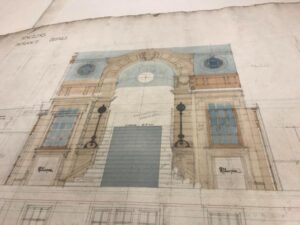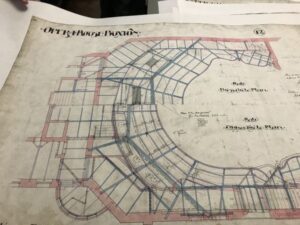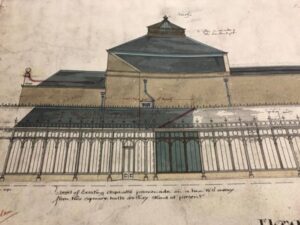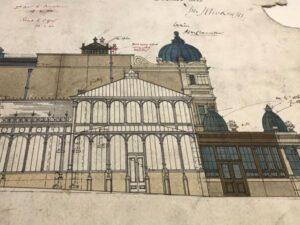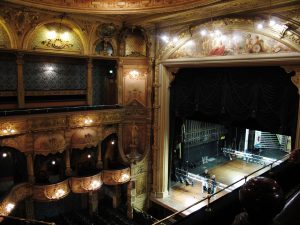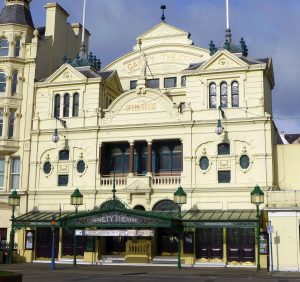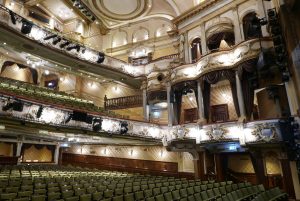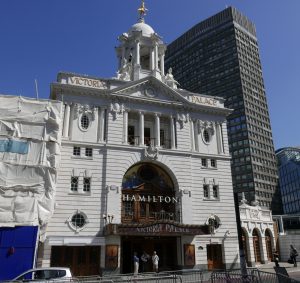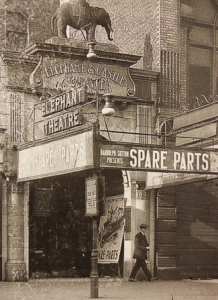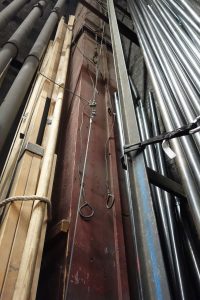We expressed our concern about the threat to the future of theatre research posed by the restructuring of the V&A archive, which is ongoing. To abandon the wealth of accumulated specialist knowledge and expertise embedded in the curators and archivists of the Theatre & Performance Department will be a terrible loss to national and international research. These proposals will be damaging to the infrastructure of research and public engagement with cultural heritage generally. We supported the SIBMAS campaign to save the Theatre & Performance Department: http://www.sibmas.org/save-the-va-theatre-performance…/
Our President Emeritus adds “When the collection moved to South Kensington, miles from its natural home in Theatreland, where an unique concentration of theatre buildings and theatre activities gave vital context to the museum, there were those who said ‘They don’t really want it. It doesn’t fit the established cast of mind at the V&A. This is just the first step toward running the subject down down until. it is safely out of sight’. The pessimists, we thought, were proved wrong when an outstanding team of experts was appointed to oversee and explain the subject and present an outstanding series of displays and special events. But perhaps the pessimists were right after all. We are now faced with an appalling act of betrayal”.
Nevertheless, the project for a V&A of the East at Stratford East London went ahead, and it is due to open in 2024/25. It is not yet known what conservation and restoration of the Frank Matcham plans archive and research access will have been achieved.
The Gaiety Theatre, Douglas, Isle of Man
Celebrating its 120th Birthday
Feature by Diana Walkden
The Gaiety Theatre & Opera House, one of Matcham’s masterpieces, was opened on July 16th 1900. Designed by the greatest theatre architect Britain has ever known, Frank Matcham, it was built inside the shell of the Pavilion Theatre (1893 by W J Rennison) and the earlier Marina, and since the 1980s has been comprehensively and sympathetically restored following the initial restoration by Victor Glasstone, which included the recreation of the rich box hangings, curtains and the fine printed wallpapers.
The auditorium has two richly Baroque plastered balconies, the lower of which continues into a range of three boxes with half-domed plaster canopies. The rectangular proscenium is set within a segment-headed frame. The tympanum is painted with putti figures. The rare painted act drop by William Hemsley was restored in 1992 and is used on a regular basis. The stalls barrier that once separated the front stalls from the pit has been faithfully restored.
The 16-segment stained glass rosary laylight, centred around the original gas sunburner, forms the central feature of the auditorium ceiling. Lit from above and enhanced with simulated gas effects from the sunburner, this completes one of the finest auditorium ceilings in the British Isles, lavish with gold leaf. The paintings decorating the magnificent ceiling represent the four seasons. There is remarkable sub-stage wooden machinery, including an extremely rare Corsican trap as well as two bridges, two cuts with sloats, two corner traps and one grave trap.
The theatre’s stucco façade was restored in 1995. It has three-storeyed towers with low pyramid roofs and dormer pediments on each face, flanking a two-storeyed centre section with a columned loggia at first-floor level, surmounted by a curved gable. Matcham incorporated the Marina’s Belfast roof truss construction into the Gaiety reconstruction. The original front canopy was restored to include leaded lights and four large lanterns mounted on the supporting columns of the canopy.
The Gaiety enjoyed considerable success, particularly in the Edwardian era until the outbreak of the First World War in 1914. Despite various attempts to make it a commercial success after that, in the years following the Second World War there was a period of structural deterioration, to such an extent that by 1970 the theatre came close to being demolished. Fortunately, that was avoided when the Manx Government purchased the building in 1971. While decades of neglect had left their mark, this had paradoxically allowed the original design features to remain intact. It is now very much a living, working theatre: a most extraordinary and beautiful theatre, continuously maintained and upgraded with the support of sponsors and the generosity of the public.
In Memoriam
Frank Matcham
22 November 1854 ∼ 17 May 1920
 Frank Matcham’s funeral took place in London five days after his death on 22nd May 1920 at St Paul’s Church in Finchley.
Frank Matcham’s funeral took place in London five days after his death on 22nd May 1920 at St Paul’s Church in Finchley. 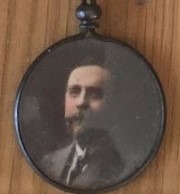 Working with the Reverend Nicholas Pye the Frank Matcham Society were organising a Memorial Service and tea at St. Paul’s one hundred years to the day on Friday 22nd May. Along with so many other celebratory plans this regrettably had to be cancelled but we would like to thank Reverend Pye for his assistance.
Working with the Reverend Nicholas Pye the Frank Matcham Society were organising a Memorial Service and tea at St. Paul’s one hundred years to the day on Friday 22nd May. Along with so many other celebratory plans this regrettably had to be cancelled but we would like to thank Reverend Pye for his assistance.
Matcham’s funeral was followed by internment at Highgate Cemetery and was reported as below:
The funeral took place on Saturday . There was an impressive service 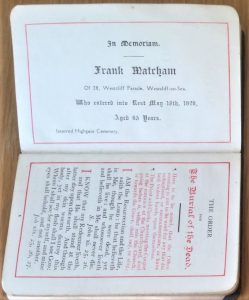 at St.Paul’s Church, Long Lane , Church End, Finchley at which the Vicar of St.Paul’s officiated. Among those present at the church were Mrs Taylor, daughter of the deceased, Mr Henry Matcham and Mr Alfred Matcham, brothers; Miss Elizabeth Matcham, Mrs Stott, Mrs Cresswell and Mrs Atkinson, sisters; Messrs JM Taylor and E G Huggins sons in law; Miss Mabel and Master Frank Taylor, grandchildren. Mr F G M Chancellor(the late Mr Matcham’s partner), Mrs Palethorpe, Mr Geo.Reader and Mr.De Jong. The funeral cortege then proceeded to Highgate (New) Cemetery, where the internment took place in the newly constructed family vault. There were many beautiful wreaths including a wonderful floral pillow from the widow and a fine tribute from Sir Oswald and Lady Stoll. Among the many others who sent wreaths were the Directors of the Stoll Co., Mr W S Gordon Michie, Mrs Adelaide Stoll. Lord and Lady Riddell, Sir William and Lady Pink, the Directors of the Empire, and Fred and Sam Fredericks of the Borough Theatre, Stratford.
at St.Paul’s Church, Long Lane , Church End, Finchley at which the Vicar of St.Paul’s officiated. Among those present at the church were Mrs Taylor, daughter of the deceased, Mr Henry Matcham and Mr Alfred Matcham, brothers; Miss Elizabeth Matcham, Mrs Stott, Mrs Cresswell and Mrs Atkinson, sisters; Messrs JM Taylor and E G Huggins sons in law; Miss Mabel and Master Frank Taylor, grandchildren. Mr F G M Chancellor(the late Mr Matcham’s partner), Mrs Palethorpe, Mr Geo.Reader and Mr.De Jong. The funeral cortege then proceeded to Highgate (New) Cemetery, where the internment took place in the newly constructed family vault. There were many beautiful wreaths including a wonderful floral pillow from the widow and a fine tribute from Sir Oswald and Lady Stoll. Among the many others who sent wreaths were the Directors of the Stoll Co., Mr W S Gordon Michie, Mrs Adelaide Stoll. Lord and Lady Riddell, Sir William and Lady Pink, the Directors of the Empire, and Fred and Sam Fredericks of the Borough Theatre, Stratford.
Victoria Palace Rave Reviews…and not just for Hamilton!
Frank Matcham’s Victoria Palace theatre, whilst not situated within London’s Theatreland, nevertheless enjoys an envious location directly opposite Victoria Station and it must be seen by millions of travellers arriving in London. This has kept it in business since impresario Alfred Butt commissioned architect Frank Matcham to replace the Royal Standard Music Hall in 1911 with this fine Grade II* listed theatre which can accommodate 1500 patrons in great style within its splendid auditorium.
It has played variety and musical productions for most of its life and for long runs in recent times under the caring ownership of theatre owner, manager and producer, Sir Stephen Whaley-Cohen who saw to the return of the gilded statue of Pavlova atop the domed facade.
In 2014 it passed to Delfont Mackintosh Theatres late in the run of the popular Billy Elliot musical, which finished in 2016. At this time the area was undergoing a massive redevelopment sweeping away many of the surrounding characterful low rise buildings with somewhat less characterful glass and steel high-rise office blocks. But the good news was that the theatre stood firm, the bulk of those we’ve lost went for far lesser reasons, but it is in the process of gaining.
The re-alignment of the surrounding buildings and re-construction below of the Underground interchange has
provided the opportunity to increase the size of the cramped stage-house and the work is ongoing to achieve this. Sir Cameron Mackintosh has continued his crusade to upgrade the theatres in his ownership and the Victoria Palace has been magnificently redecorated and furnished along with improvements to the front of house facilities, all overseen by our own Clare Ferraby, and ready for the opening of Hamilton.
The Frank Matcham Society 2018 Journal is now in preparation for members’ benefit and it will feature a piece by Giles Woodforde on the Victoria Palace project (hardback 2nd Edition now ready for launch). Meantime a few photos have found their way onto Twitter that give us a glimpse of what we can expect with Hamilton and the beautiful theatre having opened to great acclaim.
Mike Wood
Bombastic Rubbish – The Theatres of Frank Matcham
Reviewed by S B Green
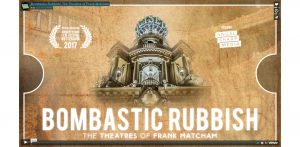 Since their presentation to the Frank Matcham Society at our Southsea Kings event in 2015, Angel Sharp Media has been working to complete this thoughtful but entertaining short film about the man and his extraordinary career in theatre building, of which only a very small selection survives more by chance than by design, and thank-goodness for that.
Since their presentation to the Frank Matcham Society at our Southsea Kings event in 2015, Angel Sharp Media has been working to complete this thoughtful but entertaining short film about the man and his extraordinary career in theatre building, of which only a very small selection survives more by chance than by design, and thank-goodness for that.
The producers gathered contributions from the technical manager (Othman Read) the successful theatre architect (Tim Foster) the cherished actor (Simon Callow) the theatre manager (Ruth Eastwood) and our own theatre historian and preservationist (John Earl) amongst others, and all filmed in some of the finest theatres ever built.
Each of the contributors deliver their own thoughts and accumulated wisdom in a thoroughly entertaining way, so as to make the subject accessible to the enthusiast and casual viewer alike. The film went on to make the official selection for the Architectural Film Festival – Rotterdam 2017. View it by clicking on the image.
Our thanks go to all of the contributors and to the production team at Angel Sharp Media.
Contributors:
Othman Read
Simon Callow
John Earl
Vicky Simon
Geoffrey Rowe
Clive Chenery
Tim Foster
David Fletcher
Ruth Eastwood
Production:
Daniel Nils Roberts
Titus Halder
Hannah Madsen
Jonathan Brodie
Featured Theatres:
Hackney Empire Cheltenham Everyman Blackpool Grand London Coliseum
A Theatre Ghost Story
by Mike Wood
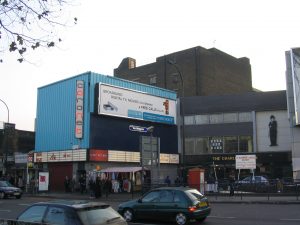 There is one of Frank Matcham’s theatre creations that haunts us, and one for which the future is bleak. It is the shadow of his very first theatre building, that of the Elephant & Castle Theatre in the London Borough of Southwark. Some may be wondering, what theatre? It is what lies behind and beyond the blue tin box of the Coronet.
There is one of Frank Matcham’s theatre creations that haunts us, and one for which the future is bleak. It is the shadow of his very first theatre building, that of the Elephant & Castle Theatre in the London Borough of Southwark. Some may be wondering, what theatre? It is what lies behind and beyond the blue tin box of the Coronet.
The Coronet at London’s Elephant & Castle is running out of time. Not content with perpetrating the gruesome pink elephant shopping centre surrounded by blocks of flats in the 1960’s, the London Borough of Southwark are now promoting a £3bn ‘new exciting destination’ on an even bigger scale and already at an advanced stage! But why would anyone want to go or live there if it had no heart; they want to demolish the Coronet for a university office block.
The Coronet is located on a site associated with entertainment for nearly 140 years. The very first theatre on this plot was built in 1872 by Dean & Mathews. Following its destruction by fire in 1878, the Elephant & Castle Theatre was built. It was designed by the prolific theatre architect Frank Matcham – his very first theatre design, and now only twenty something left in the country of over a hundred that he built.
It closed in 1928 and was then reconstructed for cinema use by Associated British Cinemas (ABC), re-opening in 1932. The architect was ABC’s W R Glen, who designed many outstanding cinemas. It gained a new façade and new auditorium seating 2,315, and to compete with the large Trocadero opposite, it had a fully-equipped stage and orchestra pit, while retaining the original dressing rooms from Matcham’s theatre and some of the exterior structure.
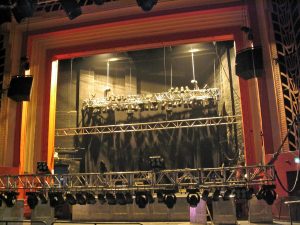 In 2003 the Coronet was refurbished, with an investment of £2m, as a multi-purpose music venue. A screen and sound system was installed so that films could be shown occasionally. The Theatres Trust and the Cinema Theatre Association have raised objections to the loss of this amazing community asset and it is currently number nineteen on the Theatres Trust Theatre Buildings at Risk (TBAR) register out of thirty-five.
In 2003 the Coronet was refurbished, with an investment of £2m, as a multi-purpose music venue. A screen and sound system was installed so that films could be shown occasionally. The Theatres Trust and the Cinema Theatre Association have raised objections to the loss of this amazing community asset and it is currently number nineteen on the Theatres Trust Theatre Buildings at Risk (TBAR) register out of thirty-five.
The Coronet has been a spectacular success as a mixed use venue, but information on a suggested smaller replacement hall has been sketchy. Town hall egos and developer’s big money seems about to bulldoze the community spirit once again. However, they should know that burying the place under ten storeys of concrete will not stop the theatre ghost from haunting them! Demolition underway in early 2021.
The Coronet closed on New Years Eve 2017 after 138 years. See the fascinating detailed illustrated history on the Arthur Lloyd website here and read the Theatres Trust database entry here.
Adapted from the Cinema Theatre Association Facebook post.
A German Thunder Run
by Adam Harrison
Back in the olden days there were sheets of iron and drums of canvas and wood to shake and turn for lightening and wind FXs. Bigger theatres might have a Thunder Run constructed and it might still be there for you to find with the traps and old wooden equipment. In London’s West End, Her Majesty’s still has an impressive large Thunder Run beside the Fly Floor stage left and although it has not been used in decades it has featured in some posters for “Phantom”. Few others remain, but there is a small one up in the roof of the Bristol Old Vic which has been restored and they intend to use for a future “King Lear”. There is video footage available online showing wooden cannon balls rolling down the shute to create the rumble noise. This was a big special effect back in the 1750’s.
These British Thunder Runs are a long shute, boxed in on all sides and built sideways so that the balls roll down a ramp by gravity. But over on the Continent they are often vertical. I saw one in Amsterdam some years ago and wondered how it might work and how it might sound. There were three control lines and three pegs so it presumably could be loaded up three times and go three times?
The Frank Matcham Society has just returned from our international trip and this year we have been in Germany. Starting in Munich and going up to Dresden with Bayreuth, Weimar and Leipzig also visited. On the way we found a private theatre in the grounds of Schloss Kochberg. Liebhabertheater was built in 1800 and now seats 75. Well the Finborough above that pub in Earl’s Court it is not! This German gem is on the Perspectiv heritage trail and is all fake marble and as delightful as it could be. Sadly Bayreuth was the disappointment as both World Heritage sites were closed for renovation at the same time, so neither opera house was seen inside, let alone their stages walked upon.
However, and it is a great big however, before we left Munich we were taken all over the Prinzregententheater. The people of Munich were not pleased that they could only see and hear Wagner by going all the way to his Festspielhaus at Bayreuth and so they opened a copy within twenty-five years. It is identical, apart from interior decoration on the walls and the orchestra pit. But the same mechanist equipped the identical sized stage. Wonder of wonders, here was a vertical Thunder Run that was all loaded and ready to be demonstrated. The Technical Director showing us round the Fly Floor, and then the under stage metal work of sliders and bridges, was a “pro” and saved the best to last. “Would we like to hear this Thunder Run?” Well, YES we would!
This one is loaded with three inch metal balls in trays at the grid and when you pull a cord the balls roll out and down the shute which has wooden bits inside for the balls to fall against. What I had not reckoned on was this could be played like a drum. First a slow rumble, then a sudden jerk caused an big bang, and then the noise could crescendo up from piano to forte to..! Such a good loud thunder sound FX. This was great! Sadly it takes time to reload all those balls from the basement up in a lift to the grid so that I could not have a go myself, but oh I did want to. Clutching my Theatre Words I did want to say – and Thunder Q1- GO! Still a big thrill to say and always a special fun to fire some big pyro bangs and flashes.
(A full write-up of the Frank Matcham Society visit to Germany appeared in the member’s Newsletter)
Remember Brighton Hippodrome? .. REMEMBER?
President Emeritus John Earl’s Article in the September 2013 Members Newsletter
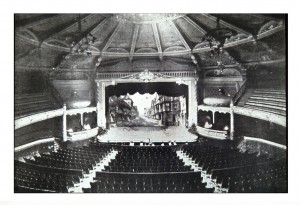
Brighton Hippodrome as a Music Hall in 1902 after conversion from circus.
The news about Brighton Hippodrome at the beginning of September (2013) was extremely depressing. There appears to be no consent application or other public papers at present on which to comment, but the broad pattern of events is fairly well known.
The once promising proposal for a popular music venue died the death, due to opposition by the police and the licensing authority, this following six years of discussion and heavy investment by the owners in skilled professional services.
The proposal that came forward to replace it was for conversion to a multiscreen complex with no fewer than eight (yes, eight) screens packed into that superb Grade II* Matcham interior. You don’t need much imagination to see that, however the feat was achieved, the great tent-like (former circus} volume would be hopelessly compromised.
The scheme will, of course, be represented as “reversible” and,
indeed, anything is theoretically reversible if you have loads of money and an improbable willingness to abandon a highly profitable use that need never have invaded the site.
In fact, once the interior has been subjected to such massive interference, the rare qualities that marked it out for Grade II* status will soon be forgotten. The likelihood of a huge investment being made to return it to theatrical, or any other amenable non-destructive use, will be vanishingly remote.
I have heard it argued that the building is now in such deteriorated condition that the choice is between an architecturally damaging project or total loss.
What I say to this is that the Hippodrome was not in serious disrepair when I examined it in 2007. Since then the City Council, if it had been worried at subsequent deterioration, had statutory power to intervene and stop the rot. It did not.
The Hippodrome’s grading puts it in the top six percent of all listed buildings in England. During its idle years no effort seems to have been made to market it or to find alternative uses other than the present multiscreen proposal. English Heritage must surely now insist on the building receiving the urgent care and attention that are no more than its due.
A last dismal thought. In the 1960s, when conservation was not a great matter of public concern, hardly any theatres (and certainly not the Hippodrome) were listed buildings and there was no powerful body like English Heritage to give a lead, Brighton corporation gave serious consideration to acquiring the Hippodrome in order to prevent its demolition.
The procedure was aborted only when Mecca stepped in and purchased the building for bingo, a use which, incidentally, caused hardly any architectural damage.
This was a remarkably early time for any authority to be considering preserving a theatre by acquisition. How times have changed!
Postscript: the Brighton Hippodrome has since been sold on again to a Brighton based developer who has announced proposals for its future as a celebrity dining venue, with reduced stage facilities, re-stepped auditorium to accommodate seating at tables, repurposed fly-tower and new hotel on the service yard, amongst other changes, but they have commenced essential repairs to the main structure, neglected by the previous owner. It remains number one on the Theatres Trust Theatre Buildings at Risk Register. See also our Theatres at Risk page here.
